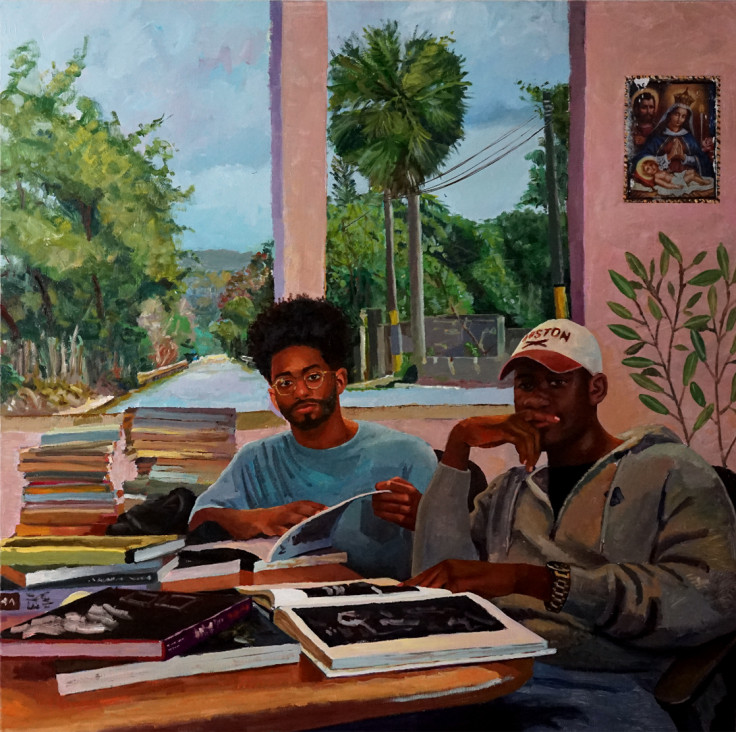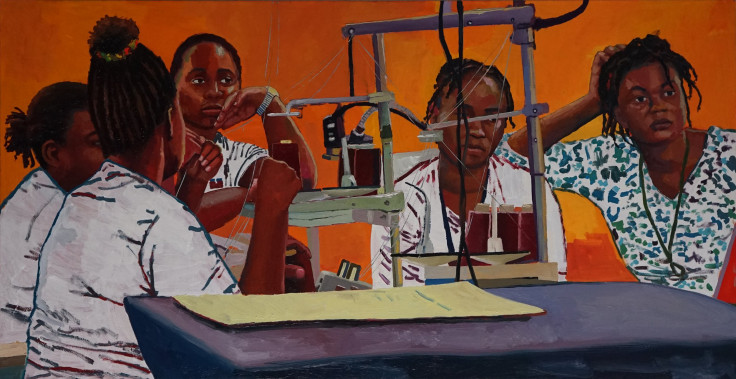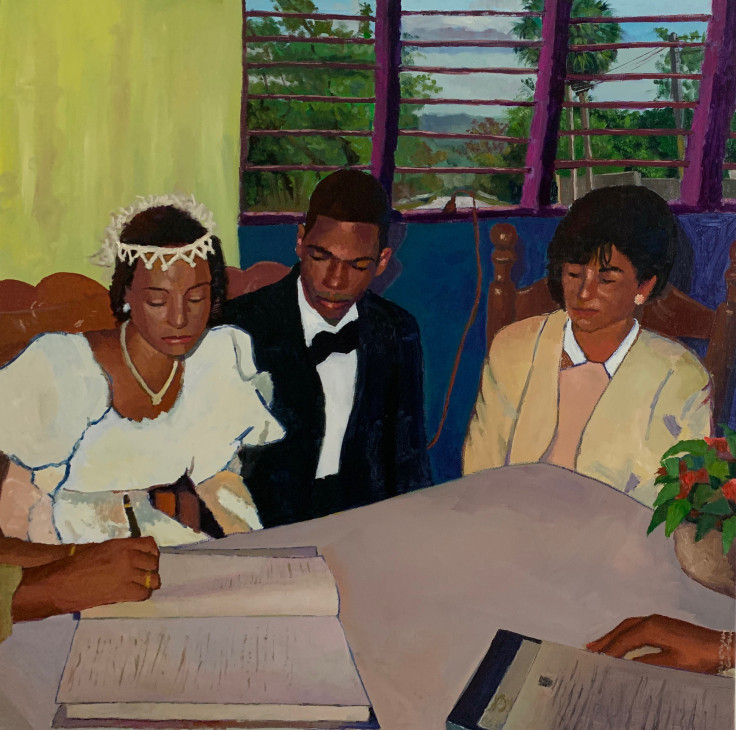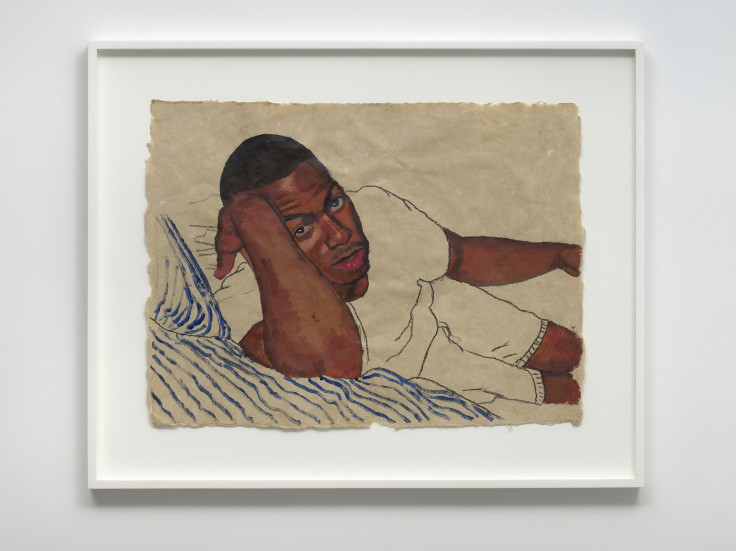
Close to 2,300 km separate Santa Cruz de Mao and New Jersey, but visual artist Raelis Vasquez has been hell-bent on closing that gap for as long as he's been creating his vivid oil paintings. Even though he mostly portrays scenes from his native Dominican Republic, his work is imbued with his own experiences as an immigrant in the city he's called home since he was 7 years old.
In Vasquez's universe, the connection between both places can appear in different forms. In some cases, passages from his Jersey life are portrayed indoors while Dominican landscapes can be seen in the background, creating a new, amalgamated space. In other, more recent cases, he's started combining oil and acrylic with beach sand from the shores of both places, a piece of his own history extending into the materials he uses.
Through it all, Raelis Vasquez has been on a journey to explore his roots and shed light on the Afro-Latino experience through his art.
"I'd go to DR every summer, and every time I felt I would arrive as a different person and then I would leave as a different person too," Vasquez tells The Latin Times. 'You eventually become a visitor. But now I'm going like two or three times a year, and I want to spend more time there as time goes by. I'm not just going to visit family; I'm searching for moments, and that search is exciting."
We recently sat down with Raelis Vasquez to talk about his process, representation in art and exploring his roots.
The following interview has been edited for clarity

The Latin Times: So tell me a bit about your process. How did you discover your own distinct style as a painter?
Raelis Vasquez: When I was an undergrad I had the opportunity to kind of think about my own life an immigrant and my family's experience. I was living in Chicago and being away from my family and my context gave me time to reflect and I think that was the genesis of my voice.
At that time I was directly influenced by the old masters like Caravaggio, Velasquez, Rembrandt. So my early work has a lot of those influences and I wanted to include my history and my experiences into that style of painting. After undergrad I searched for something different within my work. I didn't want to do the traditional lighting anymore, the claroscuro. I wanted something more vibrant to reflect how my experiences felt in Dominican Republic.
So is it safe to say you were looking for more of a Caribbean or Dominican lighting that you maybe weren't able to find with those traditional techniques?
Yeah, absolutely. And I was intentional about making that transition. I've tried to paint how it feels as opposed to how it looks. And the way that I went about that was loosening up my brushwork and through the vibrancy of the pigment.
"I didn't want to do the traditional lighting anymore, the claroscuro. I wanted something more vibrant to reflect how my experiences felt in Dominican Republic"
How much of your work comes from your family experiences? I understand the basis for it comes from photography.
It started by looking into my family photos and taking photos of my family in the States and in Dominican Republic and then collaging the photos together. I document, sketch, write, then bring material into my studio.

So just to understand a bit more. How much of your work is inspired by real life photography and how much of it is influenced by the images in your mind, what you remember from your trips to DR?
It's both. I'm documenting while I'm in the DR and well as writing and sketching. A lot of it has to do with my experiences and interactions with people.
Would you say that your relationship to the Dominican Republic has changed through your art? Has it evolved into something different now?
Well, there's a historical component to my work as I do research about Dominican history in relation to the U.S., understanding the dynamics of immigration and the narratives around immigrants. But not just immigration to the U.S. There's also the history of Haitian immigration to Dominican Republic. Hispaniola as an island, the kind of labor that's available for immigrants, whether in agriculture, construction and sometimes tourism, which is a huge part of the Dominican economy.

Can you tell me a bit about the use of sand in your work? How did you come up with it and what does it mean to you?
I started exploring with sand during grad school, when I was exploring the use of color and brushwork. New Jersey has beaches and during the pandemic I spent time in them with my family. Including sand happened during this time. The sand I included in my work is from the beaches in New Jersey mixed with the sand from the beaches in the Dominican Republic. And so I started mixing the two together in a way with the acrylics and the medium so that I could use it to paint with in specific places on the canvas. It's a way for me to combine these places that I belong to.
I've also made works where the inside of a space might be my parents apartment here in Jersey, and then, outside the window, would be a landscape in Dominican Republic. So kind of combining the two spaces and exploring what it means to belong. There's this piece called Matrimonio in which I did that, for example.

Tell me about the people you portray in your paintings. How do they react when they see themselves?
It's always interesting because there's no real conception of why I do this at first. "What is this for? Is someone going to buy a photo of me? I don't get it". The thing that I hear the most is "yo no me puse maquillaje" (I'm not wearing makeup). They want to get done up before I take photos, they want to smile, they want to pose. And I'm like "I want you as you are in this moment." But when it comes to my family, they've seen enough paintings to understand that this is what I do. I painted a photo of one of my uncles, it must've been from the 90s. I created a painting based on this image which celebrated him, and he and my family seemed to really appreciate it.
Well that's what representation is all about, right? That's the bigger conversation you're talking about.
Yes, I'm thinking about a small work on paper that I made a few years back of my father (see below). The image was taken in 2002, pretty much as soon as we moved to New Jersey. It shows that moment when we arrived, the sacrifices we made. I barely got to see him because he was working two factory jobs.

© 2024 Latin Times. All rights reserved. Do not reproduce without permission.







